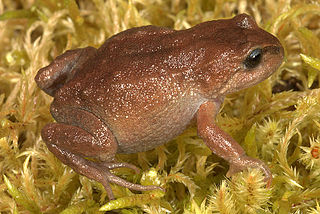
Phrynopus is a genus of frogs of the family Strabomantidae. Their common name is Andes frogs. They are endemic to Peru and inhabit the upper humid montane forest and supra-treeline grassland in the Cordillera Oriental, with one record from the Peruvian Cordillera Occidental.
Yunganastes fraudator is a species of frog in the family Strabomantidae. It is endemic to Bolivia and found in the Cochabamba Department to the border with the Santa Cruz Department. It is sometimes known as Cochamba robber frog. Its specific name fraudator means "cheat" or "deceiver" and refers to its resemblance with Gastrotheca marsupiata.
Yunganastes pluvicanorus is a species of frog in the family Strabomantidae. It is endemic to Bolivia and found on the eastern slopes of the Cordillera Oriental in the Cochabamba and Santa Cruz Departments.
Pristimantis serendipitus is a species of frog in the family Strabomantidae. It is found in the Andes of northern Peru and adjacent southern Ecuador. The specific name refers to serendipitous discovery of this species: collection at the type locality was only made because the road was closed by an accident. Common name Colan Mountains robber frog has been proposed for this species.

Gastrotheca excubitor is a species of frog in the family Hemiphractidae. It is endemic to southern Peru and occurs in the Amazonian slopes and crests of the Cordillera Oriental in the Cusco Region; records from the Cajamarca Region are likely erroneous. It is likely to include cryptic species. Common name Abra Acanacu marsupial frog has been coined for it.
Ischnocnema sanctaecrucis is a species of frog in the family Strabomantidae. It is endemic to Bolivia where it is known from the Santa Cruz and Cochabamba Departments. It is an uncommon, terrestrial frog inhabiting the Yungas forest ; it tolerates disturbed habitats. It has been found under rocks; males have been observed perching on small secondary vegetation. It is not considered threatened by the IUCN. Its range includes the Carrasco and Amboró National Parks.
Oreobates sanderi is a species of frog in the family Strabomantidae. It is found in north-western Bolivia and nearby south-eastern Peru. It is not considered threatened by the IUCN.
Oreobates saxatilis, also known as Tarapoto big-headed frog, is a species of frog in the family Strabomantidae. It is endemic to Peru and known from near its type locality near Tarapoto as well as from the Río Tambo District in the Satipo Province, Panguana in the Puerto Inca Province, and Río Kimbiri in the La Convención Province.
Psychrophrynella bagrecito is a species of frog in the family Strabomantidae. It is endemic to the Cusco Region, Peru, and found on the Amazonian slopes of the Andes at elevations of 1,830–2,740 m (6,000–8,990 ft) asl. The specific name bagrecito is Spanish meaning a small catfish, and a nickname for David C. Cannatella, a colleague of John D. Lynch, the scientist who described the species from specimens collected from near Marcapata.

Bryophryne cophites, also known as the Cusco Andes frog or the Cuzco Andes frog, is a species of frog in the family Strabomantidae. It is endemic to Peru and known only from slopes of the Abra Acanacu in the Cordillera de Paucartambo, Cusco Region. There is an unconfirmed record from a neighboring mountain range, so this species might be more widespread than current knowledge suggests.

Lynchius flavomaculatus, also known as the yellow-spotted Andes frog, is a species of frog in the family Strabomantidae. It is found in the Andes of southern Ecuador and northern Peru.
Lynchius nebulanastes is a species of frog in the family Strabomantidae. It is endemic to north-western Peru where it is known from the vicinity of its type locality, El Tambo, on the western slope of the Cordillera de Huancabamba, Piura Region. Common name Canchaque Andes frog has been coined for it.
Oreobates pereger, also known as the Ayacucho Andes frog, is a species of frog in the family Strabomantidae. It is endemic to Peru where it is known from the eastern slopes of the Cordillera Oriental and Cordillera Vilcabamba mountain ranges.

Noblella peruviana is a species of frog in the family Strabomantidae. It is endemic to the Andean highlands in Peru.
Microkayla wettsteini is a species of frog in the family Strabomantidae. It is endemic to Bolivia and only known from the region of Unduavi in the Unduavi Valley, Sud Yungas Province, La Paz Department. Common names Wettstein's Andes frog and LaPlaca's Andes frog have been coined for it. It is named for Otto von Wettstein, Austrian zoologist.

Bryophryne is a genus of frogs in the family Strabomantidae. These frogs are endemic to south-eastern Peru in the Cusco Region, with an undescribed species from the Puno Region. Their range is separated from that of Phrynopus by the Apurímac River valley.
Oreobates ayacucho is a species of frogs in the family Strabomantidae. It is endemic to Peru and known from a few localities in the Ayacucho Region in the Peruvian Andes. The species is only known from 11 specimens.

Yunganastes is a small genus of frogs in the family Strabomantidae found in southern Peru and central to northern Bolivia. They were formerly placed in the genus Eleutherodactylus as the "Eleutherodactylus fraudator group", subsequently moved to Pristimantis, before becoming recognized as a separate subgenus, and finally, a genus. Its sister taxon is the genus Pristimantis. Yunganastes are endemic to the cloud forests and humid montane forests of the Cordillera Oriental of the Andes in Bolivia and southern Peru.

Psychrophrynella is a genus of frogs in the family Strabomantidae The genus is distributed on the Andes of southern Peru and Bolivia. One of the four species assessed by the International Union for Conservation of Nature (IUCN) is assessed as "Critically Endangered".

Psychrophrynella chirihampatu is a species of frogs in the family Strabomantidae. It is endemic to Peru and known only from its type locality, the Japumato Valley in the Peruvian Andes of the Cusco. The common name Japumayo Andes frog has been coined for this species.









